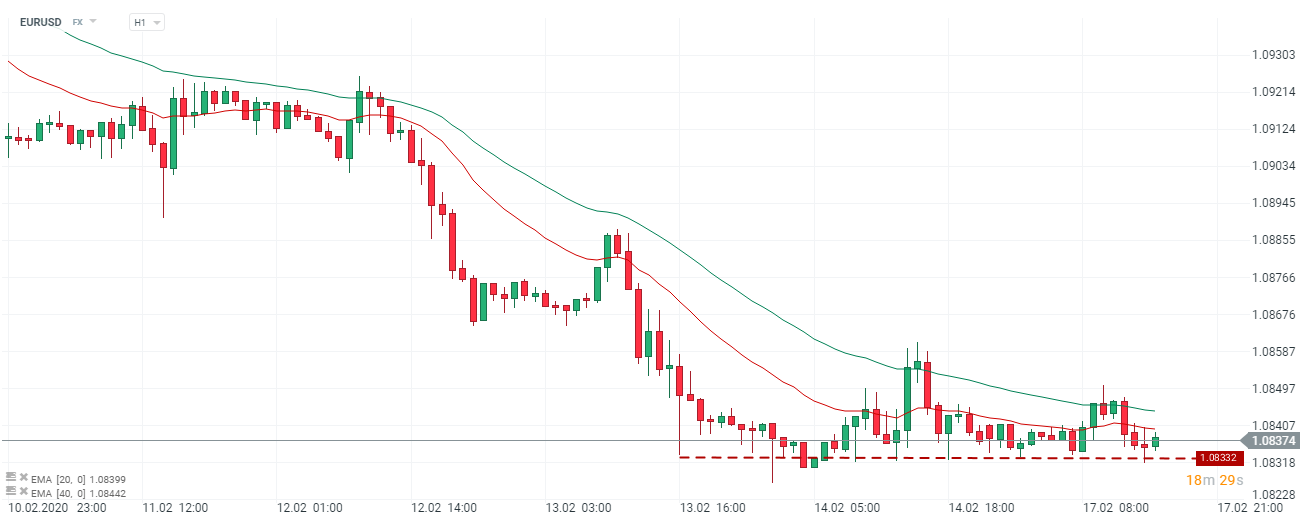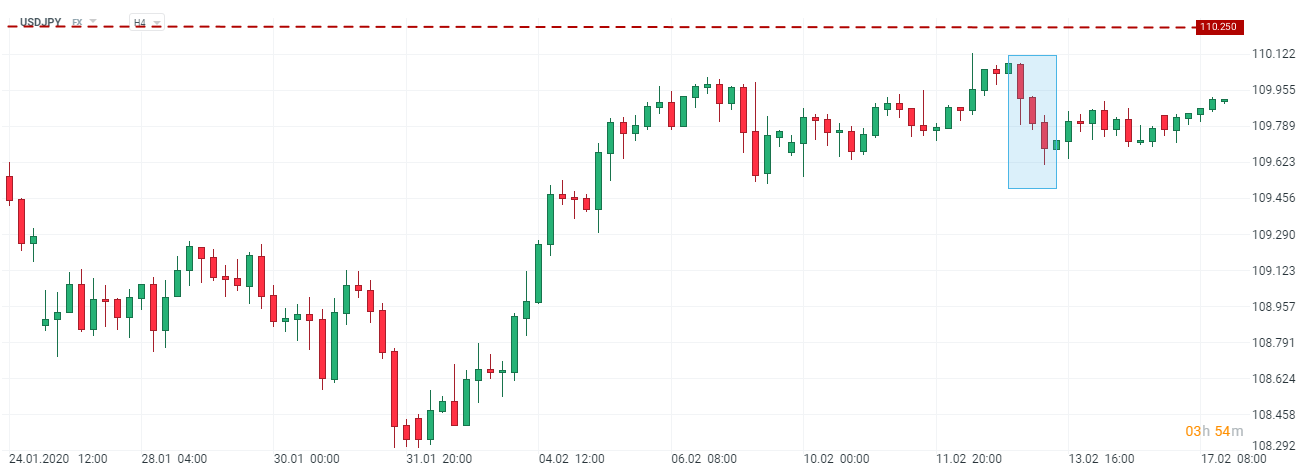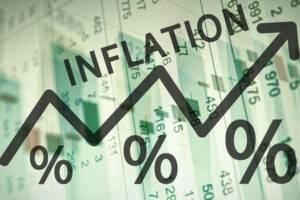Currency summary of the week. Will subsequent sessions reverse sentiment?
For the past two weeks you can feel the irresistible impression that all the time we are continuing practically two moves, based on one event, which colloquially said "dragged on" currency quotations, a good dozen days. On the one hand, we are dealing with market euphoria, which is fueled by the relatively good results of companies on Wall Street, on the other, the media is increasingly stigmatizing the development of the coronavirus epidemic. The foundations of current sentiments and market sentiment are unstable and fragile. Therefore, the current level of optimism can actually run out quickly.
The dollar does not give up
Coronavirus is slowly becoming a topic, colloquially enough to be hackneyed to such an extent as the US-China trade war, or Brexit. Despite this, the epidemic still remains a source of bad moods, and new information on the number of infected people has their impact on the markets. This is clearly seen at the USD / PLN exchange rate, in which the dollar, despite a small correction, is in constant appreciation against the zloty. We are currently facing strong resistance located at 3,9366.

USD / PLN chart, H1 interval. Source: xNUMX XTB xStation
Events in the United States themselves have been somewhat ignored by the currency market. I will remind you here of two Federal Reserve comments that appeared last week. Each of them has been virtually ignored by the market. Obviously, the meetings did not bring anything new as regards interest rates in line with market expectations. What is important, Powell said, is readiness FED to take action in the event of a downturn in the US. On the one hand, this is a reason for enthusiasm, on the other, the Reserve policy limited to actions only as a last resort, with a long-term vision, can severely limit America's stock exchanges. Monetary policy is to a large extent prevent / hedge, short-term economic fluctuations, and not be limited only to intervention when markets are in a deep recession.
The euro has slowed down
The euro depreciated strongly against the dollar last week. It is practically a dozen or so days in which USD gradually strengthens against the European currency. Industrial production in the Euro Zone is still limping. Published data are much worse than expected (on a monthly basis), which additionally does not support the vision of stabilization in this branch. Currently, trading slowed down slightly, but no demand movements on the base currency can be seen. It is difficult to say that the situation is about to turn radically (although I do not exclude it). The current price standstill at this level may be a point for further, deeper declines or a place of rebound.

Chart EUR / USD, H1 interval. Source: xNUMX XTB xStation
A good example of industry stagnation are recent reports of employment reduction at Daimler. The concern has Mercedens-Benz and Maybach. He recently published data on operating revenues, which practically fell by half compared to 2018. A general explanation of the desire to reduce employment by almost 15 employees are closing unprofitable projects. It is well known that the automotive industry, as a large part of the industrial sector of the German economy, is struggling with problems. Daimler's activities are focused on adapting production to current market demand.
Japan is still at idle
Japan, like Germany, practically all 2019 (we are talking about the overall picture without specifying for months) defended itself against the slowdown that settled in it for good. The PMI index has repeatedly exceeded the contractual limit of 50 points. However, the economy of the Country of Cherry Blossoms is not alarmingly poor. The service sector is doing quite well. On the other hand, the alarming phenomenon (which is necessarily affecting future economic conditions) is the sales tax, which increase increases the reaction of the wide market.

Chart USD / JPY, H4 interval. Source: xNUMX XTB xStation
For those less oriented in Japanese increases, the last desire to raise more money for the budget with a sales tax took place in October. Of course, its effects are best described by GDP, which, as recent data showed, was very poor. Considering recent readings, the economy fell by 1,6% on a quarterly basis. The Japanese have an outstanding talent for placement skills during potential price increases. Looking at their history (not so distant), it's enough to take a look at the sales tax introduced for the first time, which at the top of the Japanese bull market practically completely absorbed it.
Lack of flexibility BoJ and conservativeness in the allocation of Japanese savings, by no means support the (theoretical) market efficiency.






















![Forex Club – Tax 9 – Settle tax on a foreign broker [Download the Application] Forex Club - Tax 9](https://forexclub.pl/wp-content/uploads/2024/02/Forex-Club-Podatek-9-184x120.jpg?v=1709046278)
![Trading View platform – solutions tailored to the needs of traders [Review] trading view review](https://forexclub.pl/wp-content/uploads/2024/03/trading-view-recenzja-184x120.jpg?v=1709558918)
![How to connect your FP Markets account to the Trading View platform [Guide] fp markets trading view](https://forexclub.pl/wp-content/uploads/2024/02/fp-markets-trading-view-184x120.jpg?v=1708677291)
![How to invest in ChatGPT and AI? Stocks and ETFs [Guide] how to invest in chatgpt and artificial intelligence](https://forexclub.pl/wp-content/uploads/2023/02/jak-inwestowac-w-chatgpt-i-sztuczna-inteligencje-184x120.jpg?v=1676364263)


![WeWork – the anatomy of the collapse of a company valued at $47 billion [WeWork, part II] wework bankruptcy story](https://forexclub.pl/wp-content/uploads/2024/04/wework-bankructwo-historia-184x120.jpg?v=1711729561)
![Adam Neumann – the man who screwed up Softbank [WeWork, part AND] adam neumann wework](https://forexclub.pl/wp-content/uploads/2024/04/adam-neumann-wework-184x120.jpg?v=1711728724)





![How to transfer shares to another brokerage office [Procedure description] how to transfer shares to another brokerage house](https://forexclub.pl/wp-content/uploads/2024/03/jak-przeniesc-akcje-do-innego-biura-maklerskiego-184x120.jpg?v=1709556924)

![The most common mistakes of a beginner trader - Mr Yogi [VIDEO] Scalping - The most common mistakes of a beginner trader - VIDEO](https://forexclub.pl/wp-content/uploads/2024/03/Scalping-Najczestsze-bledy-poczatkujacego-tradera-VIDEO-184x120.jpg?v=1711601376)
![Learning patience: No position is also a position - Mr Yogi [VIDEO] Scalping - Learning patience - No position is also a position - VIDEO](https://forexclub.pl/wp-content/uploads/2024/03/Scalping-Nauka-cierpliwosci-Brak-pozycji-to-tez-pozycja-VIDEO-184x120.jpg?v=1710999249)
![When to exit a position and how to minimize losses - Mr Yogi [VIDEO] Scalping - When to exit a position and how to minimize losses - VIDEO](https://forexclub.pl/wp-content/uploads/2024/03/Scalping-Kiedy-wyjsc-z-pozycji-i-jak-minimalizowac-straty-VIDEO-184x120.jpg?v=1710336731)


















